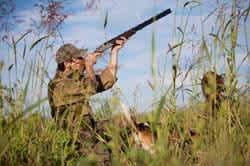Pattern Your Shotgun for Upland Bird Hunting Success
Northeast Hunting 08.19.11

Remember the old days when you were stuck with the choke that came with your shotgun? Fixed chokes had hunters filling their cabinets with guns for every purpose.
Not so nowadays, as screw in chokes have revolutionized (and optimized) shotgun performance. The array of available and easily interchangeable chokes now allows gunners to match a choke to their ammo, prey, and field conditions, thus allowing your favorite weapon to multi task.
So what’s the fun in that you ask? I like having a cabinet full of guns! After all, isn’t having way more “stuff” than you need half the fun of partaking in mansports?
Our visceral need for accumulating mountains of gear aside, interchangeable chokes are a practical and efficient way to maximize your chances for success in the field, and a trip to the range first can really pay dividends in the game pouch.
When selecting a choke (and load) for upland bird season, there are several factors to consider based on your prey, where you are hunting, and what type of dog you are hunting behind. Pheasant or grouse, dense brush or open fields, flusher or pointer, are a few of the factors you should consider. Bore size is a matter of taste, and a separate discussion for another day, so once you have settled on a 12, 16, or 20 ga. for your field work, it’s time to decide on choke and load.
Every gun is different, so it is always recommended to “pattern” your shotgun at the range to actually see where the pellets are going. Trying different chokes and loads through the same gun might be an eye opener, even for the grizzled field vet. Below are some suggestions for your consideration:
Newspaper with a 30 inch circle drawn with marker is a simple, inexpensive backing. Make a cardboard pattern to trace for fast changes. A good rule of thumb is to try for 60-70 percent coverage in a 30 inch circle at a given range.
Think about where you are hunting and the types of shots you typically get based on the terrain and how your dog works, 5 yard increments will give you the best idea
- A “cylinder” or “open choke” will deliver a desirable pattern at 25 or so yards, while an “extra full” choke allows you a tighter pattern down range at around 45-50 yards
- In between, are the “improved cylinder at 30 yards, “modified” at 35 yards, and “full” around 40 yards
- Work in lighter/heavier, low brass and high brass rounds to maximize results
- Learn from your mistakes! If you seem to be missing at a certain range, take a good look at what pattern you’re throwing at that distance-you might be surprised to find a pheasant sized hole in it!
- Remember, extra time at the range ALWAYS equals greater success in the field, and blowing through a box of shells is a great way to scratch that pre-season itchy trigger finger!
- Bring a young or beginner shooter with you, it will be a valuable lesson learned, and a great way to instill good habits in the fledgling sportsman
What’s better than an afternoon at the range as October approaches anyway? It’s a great way to get those juices flowing as the New England weather cools and our thoughts turn to morning frost and the crunch of oak leaves underfoot. Make some space in the freezer, and happy hunting!

